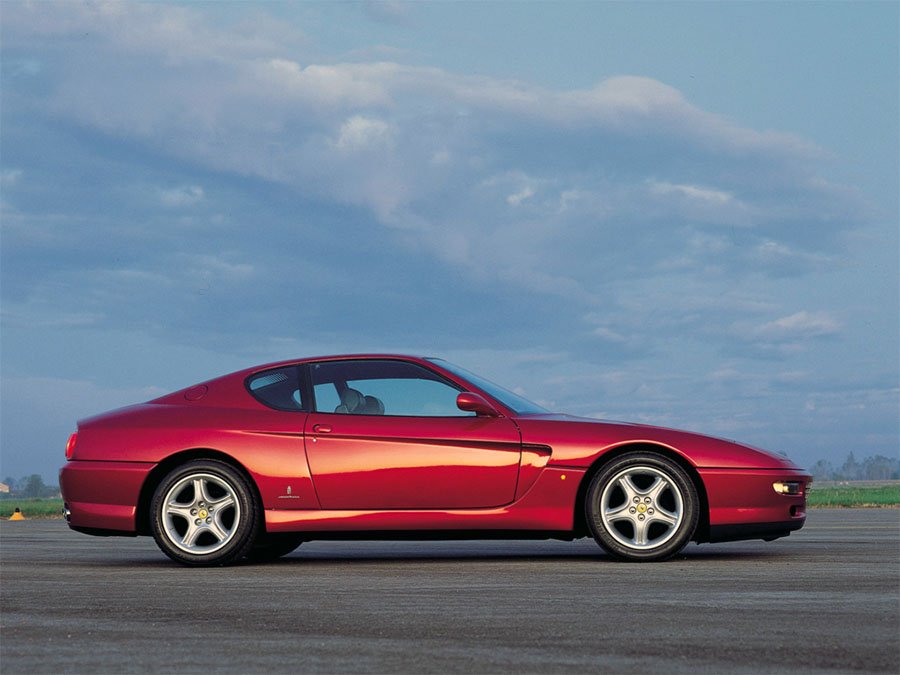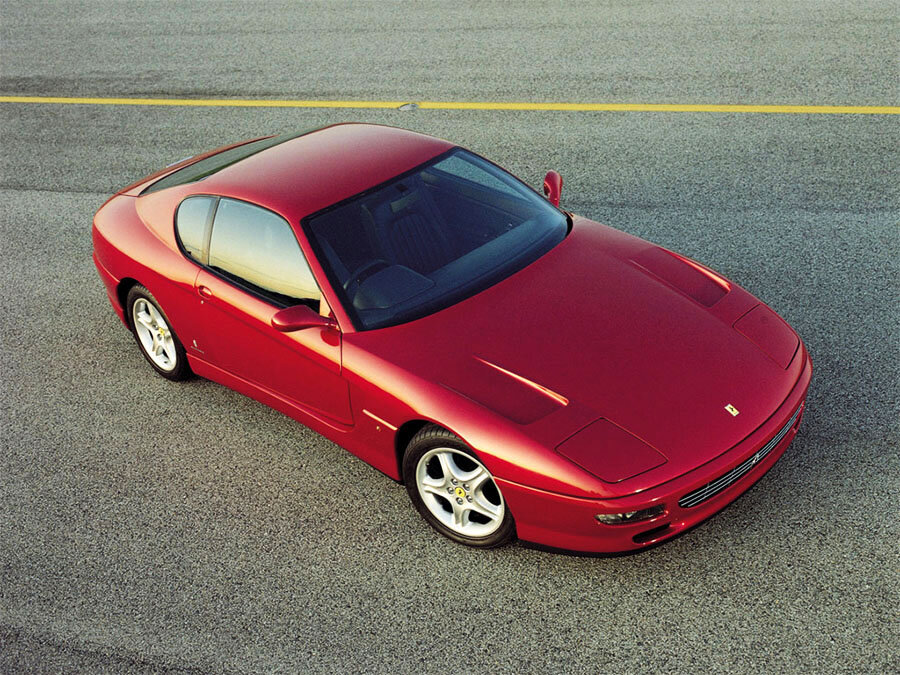Guide: Ferrari 456 - a Historical & Technical Appraisal
/BACKGROUND
The addition of a four seat series production model to Ferrari's range in late 1959 led to a dramatic uptick in sales; it meant a new type of customer was able to justify the purchase of a Ferrari on account of the increased practicality on offer.
Ferrari had created the odd coachbuilt four seater prior to 1959, but the arrival of an off-the-shelf variant, the 250 GTE, was exactly what the firm needed to complement its exciting line of two seat models.
In 1964, the 250 GTE (which had been temporarily replaced with the stop-gap 330 America) was superseded by the four-litre 330 GT. The 4.4-litre 365 GT followed in 1967.
Then, after an 18 month period without a full four seater, Ferrari introduced what became the longest running model in the firm's history.
The razor-edged 365 GT4 of 1972 took Ferrari's four seat line in a new direction. Its sharply creased notchback design stayed in production until 1989, throughout which time only a couple of minor updates were made: the engine was uprated to 4.8 litres (the 400 of 1976), fuel-injection was then added (the 400i of 1979) and finally a five-litre fuel-injected engine came on stream in 1985 (the 412i).
Between late 1989 and the autumn of 1992, Ferrari did not offer a front V12-engined four seater. Instead, customers had to make do with the rather long-in-the-tooth Mondial which had a mid-mounted V8.
However, the wait was over when the all new 456 GT was launched at the FF40 International Ferrari Celebrations that took place in Brussels and Spa Francorchamps in September 1992. The event was held to honour the 40th anniversary of Ferrari’s Belgian distributor, Garage Francorchamps.
A public debut followed at the Paris Motor Show in October.
Inspired by the 365 GTB/4, the stunning new 456 GT was a breath of fresh air and, thanks to its superlative build quality, spacious cockpit, outstanding performance and gorgeous Pininfarina styling, proved a strong seller in challenging times.
Like the 400, 400i and 412i, the 456 GT would be offered with a choice of manual or automatic gearboxes (GT or GTA respectively). However, the optional automatic ‘box did not arrive until March 1996.
The 456 initially slotted into a Ferrari range that included the 348, Mondial t and 512 TR.
CHASSIS
Whereas Ferrari’s most recent clean sheet design, the 348, had utilised a pressed steel monocoque, the 456 was based on a traditional (albeit brand new) tubular steel spaceframe designated Tipo F116CL.
At 2600mm, the wheelbase was 100mm shorter than the outgoing 412i. Track dimensions were widened by 110mm at the front and 94mm at the rear.
Independent suspension was via unequal length wishbones and coil springs over gas-filled telescopic shocks. Anti-roll bars were fitted at either end.
There was also a self-levelling rear axle.
Such a feature had first been seen on a Ferrari back in 1967 when the 365 GT was introduced. An entirely new system was ushered in for the 456. It offered two alternative suspension settings (Sport and Touring) which allowed the dampers to be perfectly configured at any time.
Sophisticated Servotronic power steering electronically adjusted the level of assistance according to road speed and conditions.
Ventilated discs were fitted all round. They had a 315mm diameter at the front and 310mm diameter at the rear. ABS was standard.
The 17-inch diameter wheels were 8.5-inches wide at the front, 10-inches wide at the rear and originally came shod with Pirelli tyres.
A 110-litre fuel tank was fitted under the boot floor.
ENGINE / TRANSMISSION
As per the chassis, the engine in the 456 was also completely new.
Unlike the Colombo and Lampredi V12s that had powered Ferrari’s illustrious line of V12 models until 1989, the engine in the 456 used a 65° instead of 60° vee angle.
Designated Tipo F116B, the block, heads, sump, crank and sundry castings were constructed entirely from light weight alloys. The alloy cylinder liners were treated with Nikasil. Dual overhead camshafts were employed along with four valves per cylinder and dry-sump lubrication.
Thanks to a bore and stroke of 88mm and 75mm respectively, the Tipo F116B motor displaced 5474cc.
Ferrari opted for a 10.6:1 compression ratio and Bosch Motronic M2.7 engine management.
All things considered, the light and compact new engine was a major step forward over the outgoing unit.
Peak output was 442bhp at 6250rpm and 406lb-ft at 4500rpm. This compared favourably to the old 412i which mustered 340bhp at 6000rpm and 333lb-ft at 4200rpm.
The 456 could initially only be ordered with a six-speed manual gearbox (Ferrari’s first). The clutch was a single-plate item and the limited-slip differential was sourced from ZF in Germany.
The gearbox was mounted in unit with the differential and final drive assembly to form a transaxle arrangement.
BODYWORK
As usual, Pininfarina were commissioned to design and fabricate the body and interior for this latest model. Pininfarina’s relationship as Ferrari’s official coachbuilder stretched all the way back to 1953. Since then, they had clothed all but one mainstream model.
Although the 412i and its predecessors had been fine looking cars, the 456 was a much sportier proposition.
Part of this was owed to the new machine’s dimensions; it came in 80mm shorter, 122mm wider and 14mm lower than the 412i.
Most of the exterior (to include the front and rear underbody) was aluminium. The hood was a single-piece of carbonfibre composite while the doors, roof panel, rear plane and pillars were steel.
Overall, the design was unencumbered by spoilers, flares or blisters although there was an electronically-activated spoiler located in a cut-out on the rear apron. The angle of this spoiler changed to increase downforce according to road speed.
In additional to its many traditional design cues, the 456 was the last Ferrari created with pop-up headlights.
INTERIOR
The sumptuous interior was beautifully designed and extremely well appointed.
Aside from the carpeted floors and sidewalls plus aluminium inserts for the steering wheel and centre console, practically every surface was covered in fine Connolly leather.
Directly behind the three-spoke steering wheel was a curved binnacle that housed a large speedometer and rev counter in addition to a plethora of warning lights. Five smaller read outs (fuel, oil pressure, water temperature, oil temperature and a clock) were housed under the air-con vents on the centre console. Just ahead of these was a traditional open gate gear lever.
The dash top, door caps, steering wheel rim, forward section of the headliner and A pillars were usually upholstered in black leather.
In addition to full leather, standard equipment included air-conditioning, electric windows, electric mirrors and an audio system.
One of the modern touches added by Ferrari was windows that lowered slightly when the doors were opened and closed which allowed compressed air to escape from the cockpit.
OPTIONS
As a result of the very high standard specification, optional extras were limited to a five-piece set of Schedoni luggage, seat piping and out of range colours for the paintwork and interior.
WEIGHT / PERFORMANCE
At 1690kg, the 456 weighed 115kg less than the 412i.
For a vehicle that offered so much space, its performance was extraordinary.
0-62mph required just 5.2 seconds and the top speed was 186mph. Even more impressively, the 456 could lap Fiorano several seconds quicker than a 512 TR and 348.
LAUNCH
Although the 456 was launched in the depths of a severe economic recession, it proved a commercial hit.
Road testers were impressed with the car’s blend of style, build quality and continent-crushing performance; never before had a Ferrari combined such looks and performance with an interior spacious enough to seat four adults.
US VERSION
Although the 456 was designed as a world market car that could meet the most stringent safety and emissions legislation without major modification, the 456 was not offered in the USA until the summer of 1994.
US versions were identifiable by their rectangular side marker lights located down each flank.
1995 PRODUCTION CHANGES
During 1995, airbags were added to all US-bound cars and became optional in other markets.
To accommodate an airbag, the original three-spoke steering wheel was switched to a new four-spoke design.
456 GTA
Although Ferrari always intended to develop an automatic version of the 456, it was a surprise such a machine did not appear until the Geneva Motor Show in March 1996.
The four-speed automatic transmission used in the GTA was created in collaboration with Ricardo (formerly FF Developments). Ricardo designed and built the gearbox around General Motors internals.
An electronic management system automatically adapted to different driving styles which dispensed with the need for a kick-down mode.
The GTA’s 0-62mph was just two tenths slower (5.4 seconds). Top speed dropped from 186mph to 185mph.
GTAs were given a new chassis designation: Tipo F116CLA as opposed to Tipo F116CL.
1996 PRODUCTION CHANGES
When the 456 GTA was launched, Ferrari replaced the Tipo F116B engine used thus far for the latest F116C unit which came with the improved Bosch Motronic 5.2 engine management.
Similarly, remote central locking was added to the list of standard equipment.
At the same time, body production was transferred from Pininfarina to Scaglietti.
END OF PRODUCTION
Production ended in early 1998 by which time 1951 examples had been built.
Of these, 1548 came with the manual gearbox (141 in right-hand drive) and 403 with the automatic transmission (61 in right-hand drive).
A believed 73 456s were sold to the Sultan of Brunei of which 17 were converted by Pininfarina with custom bodywork. The 17 Brunei specials comprised Saloon (7), Convertible (4) and Estate (6) body styles.
The revised 456 M (covered separately) was launched at the Geneva Motor Show in March 1998. It came with a host of subtle modifications and remained in production until 2004 when the 456 was replaced by the 612 Scaglietti.
Text copyright: Supercar Nostalgia
Photo copyright: Ferrari - https://www.ferrari.com








































